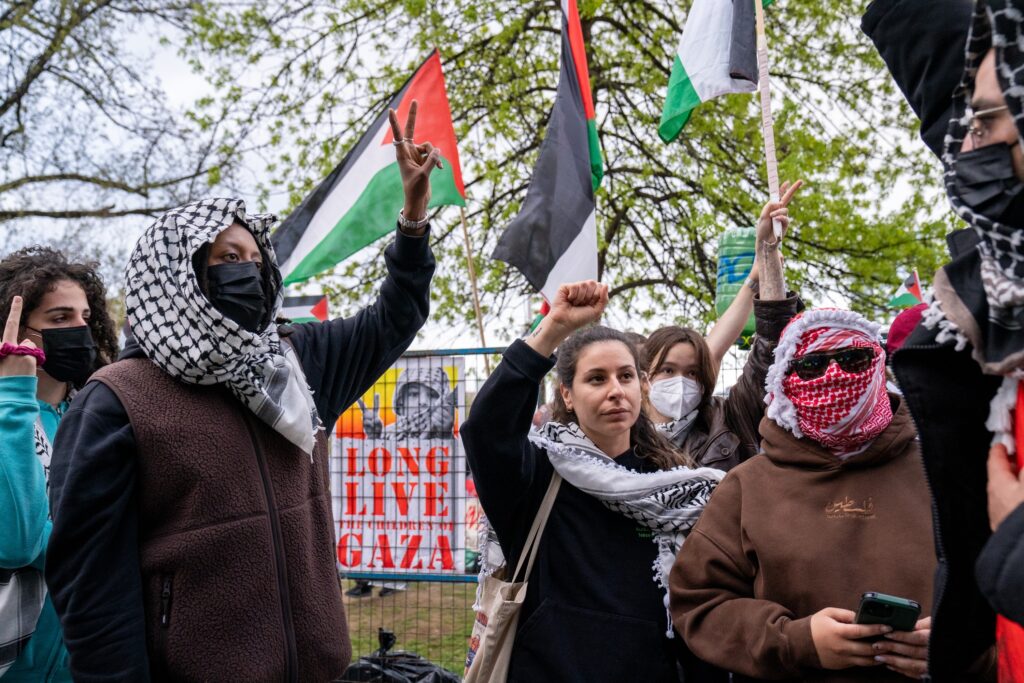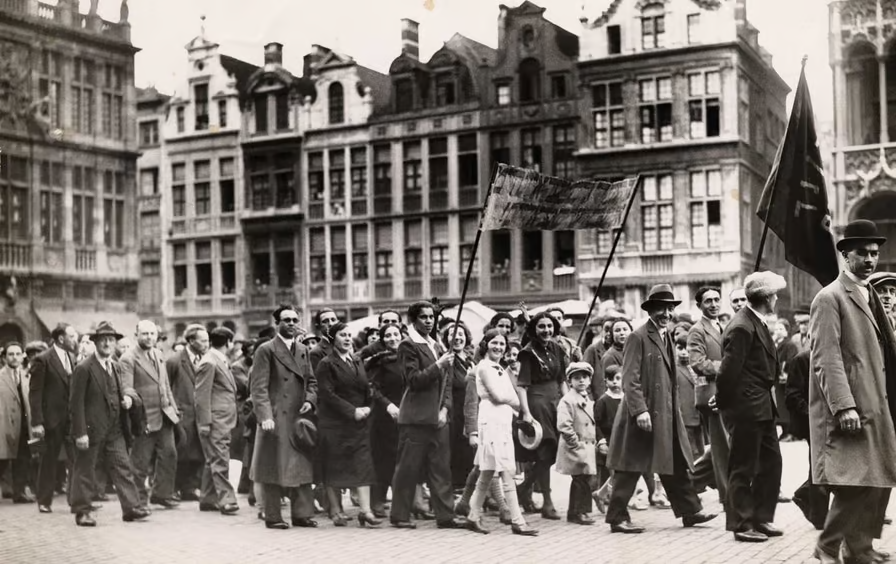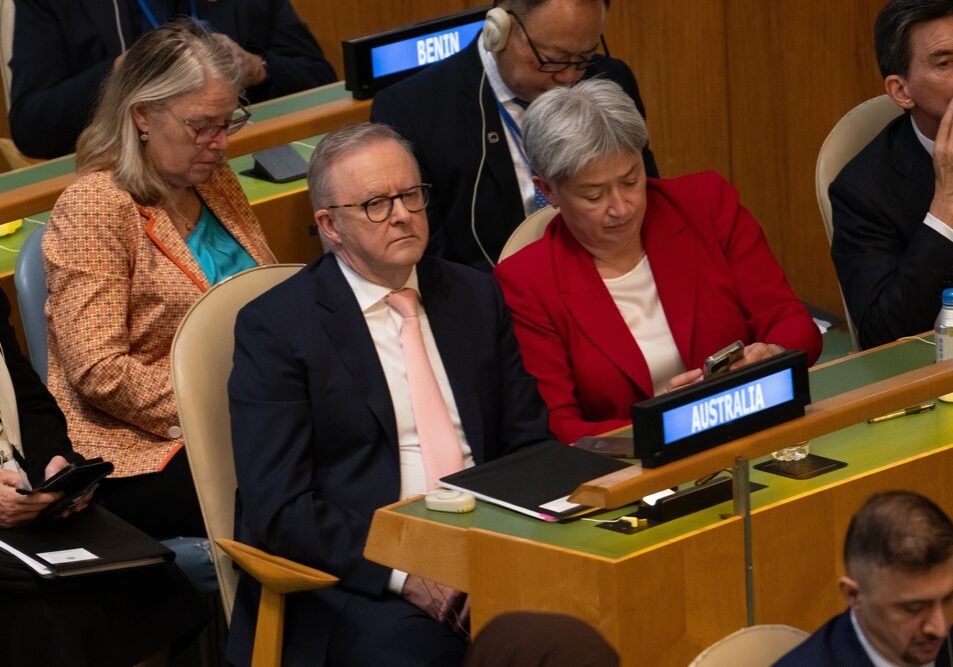Australia/Israel Review
Essay: Fading towards Fascism
Apr 28, 2025 | Shalom Lappin

The Jews and the postmodernist left
Since the Hamas terrorist attack of October 7, 2023, Diaspora Jews have found themselves under sustained assault on a variety of fronts, from much of the radical left, and its Islamist allies. People who pose as guardians of equality and anti-racism are leading violent demonstrations praising mass murder attacks against Israelis. They are urging the exclusion of all Jews who do not endorse their views from the mainstream of the social order. How did it come to pass that such a significant portion of the contemporary radical left now resembles fascist and Nazi groups of the past?
The Old and the New Lefts
In the first half of the twentieth century, much of the left regarded class struggle as the engine driving the dialectic of history. The proletariat was seen as the primary agent of progressive social change, and labour movements were the instruments through which it was harnessed. The radical left created revolutionary Communist regimes in Russia and China. These were countries with underdeveloped economies that were largely agrarian. In the industrialised West, the social democratic left achieved substantial economic reforms through labour unions and parliamentary political processes. These reforms produced welfare states that ameliorated the poverty of wage earners, and that facilitated their social mobility.
By the 1960s, the radical left had despaired of workers in the West as the primary vehicle of change. It saw them as too heavily invested in the economic and social institutions of welfare capitalism to pursue a revolutionary political agenda. The emerging New Left turned to the national liberation movements overturning colonial rule in the third world as a substitute for the working class. The struggle of African Americans for equality, and, subsequently, of feminist and gay rights campaigns against gender exclusion, were incorporated into this movement as core elements of a redefined liberation struggle.
Marx was not particularly interested in colonialism. He devotes only a brief ten-page chapter to it at the end of Volume 1 of Capital. In his description of British rule in India, in an article for the New-York Daily Tribune (June 25, 1853), he presents British colonialism as brutal and self-serving, but progressive in its destruction of traditional social patterns.
When the New Left shifted its focus from working class politics to anti-colonialism and the rights of marginalised ethnic and gender groups, it initially saw this move as a revision of a classical Marxist view. This change was required to adapt to the new conditions of the postwar era in the West. The anti-colonialist movements pursuing national liberation in the 1950s and 1960s were, for the most part, secular, and broadly aligned with the ideological perspectives of the classical Western left. They claimed allegiance to socialism and democracy.
The Left and the Jews: Unrequited Love
From its beginnings in the revolutionary movements of the 18th and 19th centuries, the European left had difficulties with Jews. They were not a natural constituency for its struggle, as they could not be easily assimilated to the European categories of religion, nation, or cultural ethnic minority. They clearly exhibited properties of all three, without being straightforwardly reducible to any one of them. They were geographically disparate in a far-flung diaspora, and they were distributed across the full range of socio-economic roles, encompassing impoverished working-class masses, entrepreneurs, financiers, and bourgeois professionals. They were subject to millennia of persecution, expulsion, mass violence, and exclusion in Europe and the Middle East, but they were not the sort of oppressed group that could be easily harnessed to the types of liberation campaigns that constituted the agenda of the left. This agenda focussed on the freedom of nations, the liberation of workers, the abolition of slavery, segregation, and apartheid, and the empowerment of women. By the beginning of the 20th century there was a sizeable Jewish working class and Jewish labour movements of various political orientations (the Bund, Jewish Communists, Anarchists, and Socialist Zionists), in both Eastern Europe and North America. However, the traditional association of Jews with capitalism and finance rendered them suspect, and they were frequently cast as class enemies.
Jews flocked to the left as the instrument for escaping antisemitism and poverty. But the left never regarded Jewish emancipation as one of its core concerns. It was to occur as a side effect of the universal workers’ revolution that would bring freedom to all people. Antisemitism itself was regarded as an epiphenomenon of backward social organisation and the superstitions that sustained it. This prejudice, along with other forms of racism and bigotry, would disappear when this structure was replaced by a genuinely egalitarian order. Both the revolutionary and large parts of the social democratic left envisaged this process as also requiring the disappearance of Jews as a historical entity. The view of Jews as an unnatural and illicit collectivity is deeply embedded in European and Middle Eastern societies. It has informed much of the left’s attitude toward Jews from its inception. It is a preoccupation shared with the ethno-centric European right, and it constitutes a common cultural inheritance.
When Jews insisted on highlighting antisemitism as a central concern for progressive politics, they were accused of reactionary particularism. Zionism was dismissed in this way. So was the anti-Zionist, diaspora cultural autonomism of the Bund. The popular notion that the left was a strong ally of Jews due to its anti-fascist stance is largely mythology. It did little to support Jewish refugees fleeing Nazism in the period leading up to the Second World War, preferring to focus on political victims of the regime. During and immediately after the war, much of the left resisted attempts to present the Nazi genocide as a Jewish cataclysm. For the most part, it took no great interest in the hundreds of thousands of survivors languishing in refugee camps immediately after the war. It did not respond to the expulsion and forced emigration of Jews from Arab countries in the late 1940s through to the early 1960s. It did not see the oppression of Soviet Jewry, or the desperate flight of Ethiopian Jews, as issues of progressive concern.

Jewish Bundists marching in Brussels, 1935 (Image: YIVO/ Institute for Jewish Research)
A large part of the New Left adopted the secular anti-Zionism of the PLO, and they embraced its program for a ‘secular democratic state’ in Palestine. Many advocated a ‘de-Zionised’ Israel, to which all Palestinian refugees and their descendants would be permitted to return. The mode of implementation of these policies, and their implications for the Jewish majority in Israel, were left carefully unspecified. The proposal was packaged as an equal rights for all arrangement. The New Left identified the Palestinian cause as one among many national liberation struggles, and it construed Israel as an appendage of American imperialism. Israel was not a primary focus in its revised understanding of the postwar revolutionary struggle. It never occurred to the New Left of the 1960s to target Diaspora Jewish communities, either on campus or off, as enemies of its cause, regardless of the views on Israel and Zionism that were dominant in these communities.
The Failure of Secular Nationalism and the Rise of Islamism
The failure of secular Arab nationalism became fully apparent by the end of the 1960s. Israel’s victory in the 1967 war shattered Nasser’s pan-Arabist vision. The Baathist parties in Syria and Iraq had constructed murderous regimes. The Algerian, Tunisian, and Libyan national liberation movements produced similar results. In all of these cases, independence had been achieved only to yield oppressive governments that maintained stagnant, underdeveloped economies with wide-spread poverty and sharp inequality. The rhetoric of third world socialism rang increasingly hollow in these, and in many other, post-colonial countries.
Theorists of political Islamism, such as Muhammad Rashid Rida, emerged at the end of the 19th century and the beginning of the 20th, to challenge the importation of Western ideas of nationalism, liberalism, and socialism into the Middle East. Hassan al-Banna founded the Muslim Brotherhood in Egypt in 1928, and it became one of the major organisations for promoting Sunni political Islamism. Haj Amin al-Husseini, the Grand Mufti of British Mandatory Palestine, and one of the leading architects of the Palestinian national movement, was closely associated with the Brotherhood. Sayyed Qutb published Milestones (Ma’alim fi’l-tareeq) in 1964, which called for jihad to establish a universal caliphate.
From its beginnings, political Islamism identified the Jews as primary agents of corruption responsible for the introduction of subversive Western ideas into Muslim societies. It regards them as one of the main causes for the fall of the Ottoman Caliphate in 1924, and casts them as a leading edge of Western domination of Islamic lands. This theme in Islamist thought predates the creation of Israel by decades. The Islamists adapted the antisemitism of European ethno-nationalism to fashion an Islamic version of classical anti-Jewish conspiracy theories. The Muslim Brotherhood had strong pro-fascist and pro-German sympathies in the 1930s and during the war. Qutb’s Our Battle Against the Jews (Ma’rakatuna ma’a al-Yahud), written in the early 1950s, describes Jews as perfidious adversaries of Islam from the seventh century onwards. The conflict with Zionism and Israel is portrayed as the latest instance of a cosmic struggle in which Jews are assigned a demonic role much like the one that they play in traditional Christian and far right European nationalist eschatologies.
The Islamists target secular nationalist regimes in Muslim countries as tools of Western oppression. They also regard the high culture of mediaeval Islamic empires as a perversion of Islam. They seek to restore a mythic pristine era of early Islam from the age of the Prophet Muhammad and his followers. Arab and Turkish nationalists saw the Islamists as a reactionary threat to their modernising movements, and they suppressed them. After these nationalist movements failed, Islamists filled the political vacuum that they left. When the coalition of anti-government groups that supported Khomeini overthrew the Shah of Iran and he returned from exile in France to establish a Shi’ite Islamic Republic in 1979, one branch of Islamism achieved state power. One of the first actions of the Khomeini regime was to brutally repress the left-wing groups that had supported his revolution, particularly the Iranian Communist Tudeh Party. The victory of the Taliban in Afghanistan created a Sunni Islamist state allied with al-Qaeda. Sunni and Shi’ite jihadi groups, in competition and in occasional opportunistic alliance, have achieved considerable political and military influence throughout the Middle East, as well as in parts of Africa and Asia. They have also become a significant presence within the sizeable immigrant Muslim communities in the West, where they have displaced much of the more moderate religious and cultural leadership of previous generations.
The radical left transferred its allegiance from secular third world national liberation movements to radical Islamists as a new and potent vehicle for anti-colonialism. This move was facilitated by a significant transformation in the New Left itself. In the past 30 years, it has morphed from a movement inspired by a revised version of Marx’s vision of a revolution based on class, and on Western Enlightenment values of reason, freedom, and equality, into a postmodernist ideology defined by the identity politics of ethnicity, gender, and indigenousness. This shift moved the theoretical foundations of the radical left from political economy to critical theory, ethnic and gender studies, and postmodernist doctrines of cultural relativism. Addressing the injustices inflicted on ethnic and gender groups by White European racism and colonialism became its focus. European colonialism is regarded as the source of all racism and injustice, while non-European colonialism, such as the Ottoman Empire, and Soviet domination of central Asia, are disregarded as irrelevant.
Indigenousness is fetishised as the condition of original innocence, despite the fact that it has no clear substance for many of the areas to which it is loudly applied. This is most glaringly obvious in the case of the Middle East and North Africa, which have been subject to continuing invasions, and influxes of populations, over the past four millennia. The notion of a stable cohesive native population in these territories is a historical fiction. The Muslim Arab conquest of the Middle East in the seventh century subordinated Jewish, Byzantine, and Aramaic speaking Christian communities to Arabisation and Islamic rule. It also Islamised Persia. Their conquest of North Africa and Iberia extended forced Arabisation to Egyptian, Greek, Berber, and Visigoth peoples. Turkish speaking people moved from central Asia into Anatolia in the 11th century. The Ottomans subsequently imposed Turkish rule and settlement on large areas of the Middle East, Armenia, North Africa, Cyprus, and the Balkans, which they incorporated into a large Islamic empire. The sequence of invasions and population flows in these areas throughout ancient, mediaeval, and modern history renders the notion of an indigenous population in these regions largely without content.
An Identity Politics that Targets Jews
In constructing an identity-driven alternative to the class-based ideology of the traditional left, the postmodernist left has devised an ethnic and gender hierarchy of virtue that is the inversion of the one invoked to support the racial politics of the ethno-centric far right. The ethnic and gender groups victimised by Western colonialism are effectively reinterpreted as noble savages, in the sense popularised by 17th- and 18th-century philosophers, who imagined them flourishing in natural environments uncorrupted by the oppressive norms of European society. This fantasy became the basis for an irrationalist stream of romantic thought in the 19th century, that celebrated primitiveness. Nazism appropriated elements of this movement in its blood and soil racial nationalism. The noble savage view of native peoples in (and from) colonised countries is, at root, the expression of a profoundly paternalist, racist view of non-Europeans, which infantilises them. It treats them as fundamentally different from Western people, depriving them of both agency and responsibility.
Under the guise of promoting diversity and equality, the identity politics of the postmodernist left has overturned the broad coalition-building agenda of classical progressive movements. It has replaced it with the worship of ethnic and gender difference, based on inherited virtue conferred by a history of European colonial dispossession. The purpose of this exercise appears to be not the creation of a social order that provides fully democratic institutions and genuine equality to all its members, but a permanent acknowledgement of original sin and past guilt by the descendants of the colonisers, and those who benefit from the privileges that they enjoy.
Jews fare as badly in the ethnic politics of the postmodernist left as they do in those of the White supremacist right. In both systems, they are regarded as beneficiaries of illicit privilege who abuse and exploit the rightful owners of the societies that they corrupt. In both systems, they are indelibly alien, at home nowhere, and native to no country or culture. In both world views, they control vast financial and political power, which they use to manipulate governments and financial institutions to dispossess native peoples, and to advance their own nefarious ends. From the White supremacist perspective, they are a vagrant Middle Eastern people preying upon the wholesome native cultures of Europe and North America. The postmodernist left casts them as particularly troublesome beneficiaries of White privilege, who have established a colonial settler state in Palestine. They have allegedly mobilised an international conspiracy to sustain this state, and supposedly exploit vulnerable ethnic minorities throughout the countries of their diaspora, particularly in America.
Contemporary Antisemitism: Continuities and Innovations
One of the most salient features of antisemitism is its capacity to reformulate itself in distinct idioms in different historical contexts. Throughout the mediaeval period, it was expressed as a religious prejudice rooted in Christian doctrine concerning the role of Jews in the crucifixion of Jesus and their refusal to accept the Gospels. In the 19th century, it reinvented itself as a pseudo-scientific racial theory concerned with the intrinsic properties of a mythic Jewish ‘race’. Contemporary anti-Zionists claim that they are only objecting to Israel and its supporters. They have no problem with Jews, and they are opposed to antisemitism.
The postmodernist left is now using anti-Zionism as cover for anti-Jewish racism. Its target is not the government of Israel or its actions, but its people. It does not distinguish between progressive and right-wing Israelis. It seeks to annihilate Israel as a country, where half of the world’s Jewish population lives. It marks the overwhelming majority of Jews abroad, who affirm Israel’s right to exist, even within its 1967 borders, as enemies of decency, to be violently excluded from the social mainstream. It poses as a political programme for securing Palestinian rights, while it promotes hostility to Jews as a collectivity.
There is a clear precedent for this use of anti-Zionism as a vehicle for racial and political antisemitism. The Stalinist purges of the 1950s in the Soviet Union and Eastern Europe featured campaigns against Jews, who were described as cosmopolitans and Zionist agents. In 1968-69, the Polish Communist Party conducted an anti-Zionist attack on the postwar remnant of its Jewish population of 35,000, resulting in the forced emigration of approximately 25,000 of them.
But the anti-Zionist antisemitism of the postmodernist left is distinct from that of the Stalinists. The latter was formulated in classical Marxist-Leninist terms of class struggle and revolution. Those accused of being Zionists were painted as agents of capitalist and imperialist subversion of a socialist state. The former variant is increasingly understood in the context of the anti-colonialist alliance between the postmodernist left and radical political Islamism.
Since the Hamas mass terrorist attack of October 7, 2023, the more militant wing of the contemporary radical left has explicitly celebrated Hamas, Hezbollah, and other elements of the Iranian axis, as authentic expressions of resistance to Zionist occupation. It has endorsed their eliminationist program of mass murder and expulsion of the Jewish population of Israel. It has taken up their call to assault Jewish communities in the Diaspora as centres of Zionist activity. The demand for a global intifada has been translated into a policy of classifying any Jew not willing to actively support the destruction of Israel as a Zionist, and hence a legitimate target.
This component of the postmodernist left has mounted a growing movement for the delegitimisation of organised Jewish life, and the banishment of “Zionist” Jews from public spaces in education, the arts, media, and the professions. It includes boycotts of Jewish businesses with any perceived connection to Israel, and increasingly violent attacks on Jews both on and off university campuses. These developments recall the escalating exclusion of Jews from public life in Nazi and fascist countries throughout Europe in the 1930s. This part of the radical left has evolved from socialism to a variant of national socialism. The inverted ethnic and gender hierarchy that drives its activism, and its presentation of Israel, with its Jewish supporters, as the agent of a cosmic conspiracy for colonising oppressed peoples, corresponds to the racial politics of the Nazis. In the often-violent pro-Hamas demonstrations that have been taking place this past year and a half throughout Western countries, the Hamas red triangle has become a modern swastika, and the checkered keffiyeh used to cover the faces of demonstrators is assuming the role of a latter-day brown shirt.
The Move to the Far Right: Broken Reeds and False Friends
While the postmodernist left now constitutes a serious threat to the survival of open and organised Jewish life in the Diaspora, it has little prospect of achieving electoral power. In fact, the large majority of the electorates in most countries have recoiled in fear and disgust at the sight of its embrace of Islamist extremism. They have sought refuge in far-right parties which are fast gaining power throughout Europe and North American. This reaction appears to have been a factor in Trump’s recent election. The trend towards these two poles of extremism is the expression of much deeper social and economic problems, in particular the sharp rise in economic inequality and the attendant dislocation that it is causing. As in past periods of serious instability, the entry of antisemitism into the mainstream of public opinion is a symptom of underlying social pathology.
Some Jews in the Diaspora, and many in Israel, see the rise of far-right governments as a source of rescue. This is a serious mistake. While these regimes might be hostile to the immigrant groups within which Islamist agitation has become entrenched, they draw their core support from nativist bases for which antisemitism is as integral to their belief systems as hostility to immigrants. These movements tend to be strongly sympathetic to Putin, who is strategically aligned with the Iranian axis. They are entirely unreliable as supporters of Israel. In no way can they be seen as guarantors of Jewish security. Jews are now caught directly in the crossfire between the extremes of the radical postmodernist left and the racist far-right, as the centre falls away into ineffectiveness. Embracing either of these extremes is as self-destructive as it is self-debasing.






